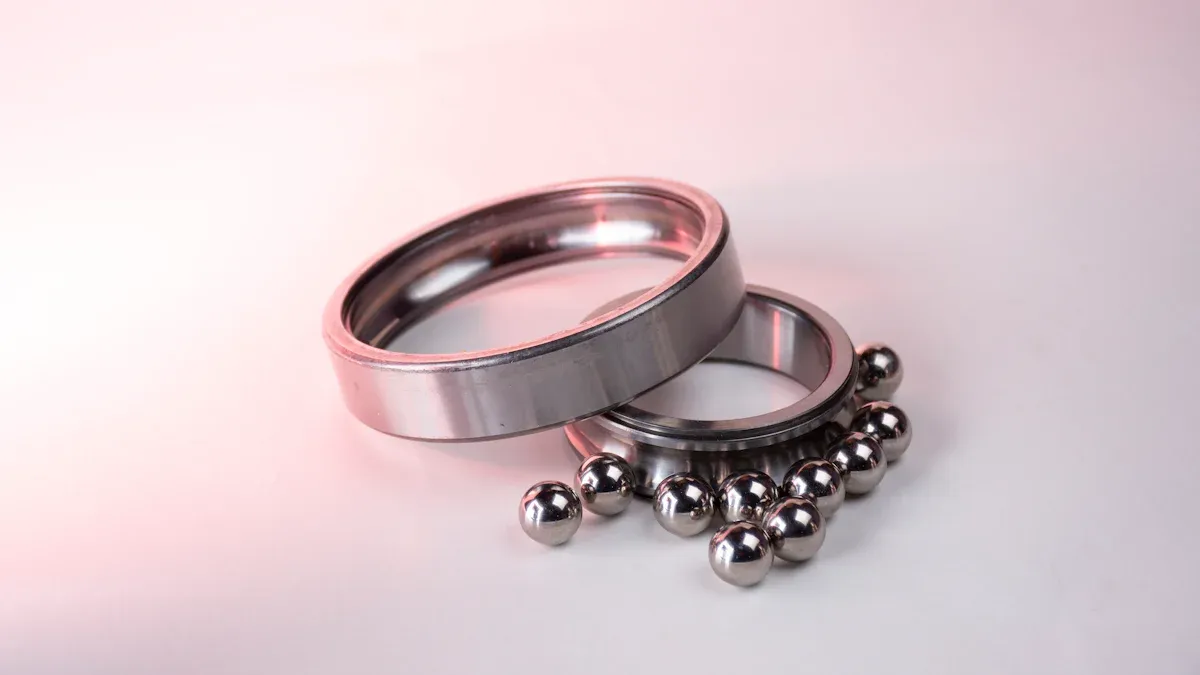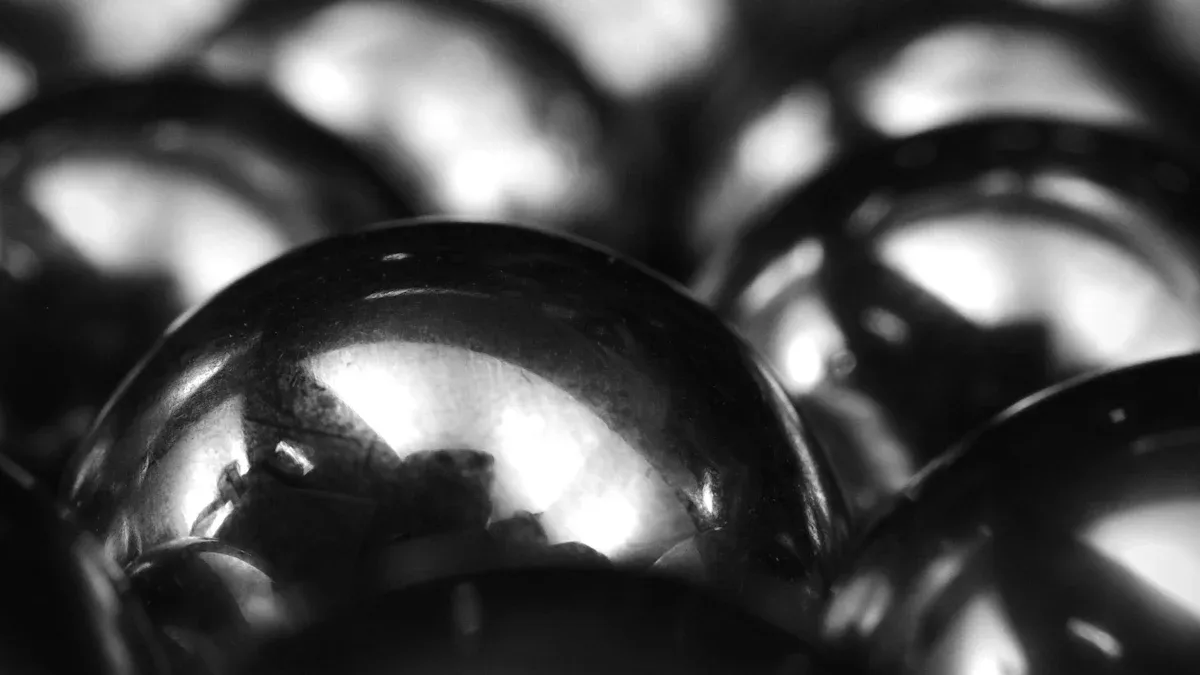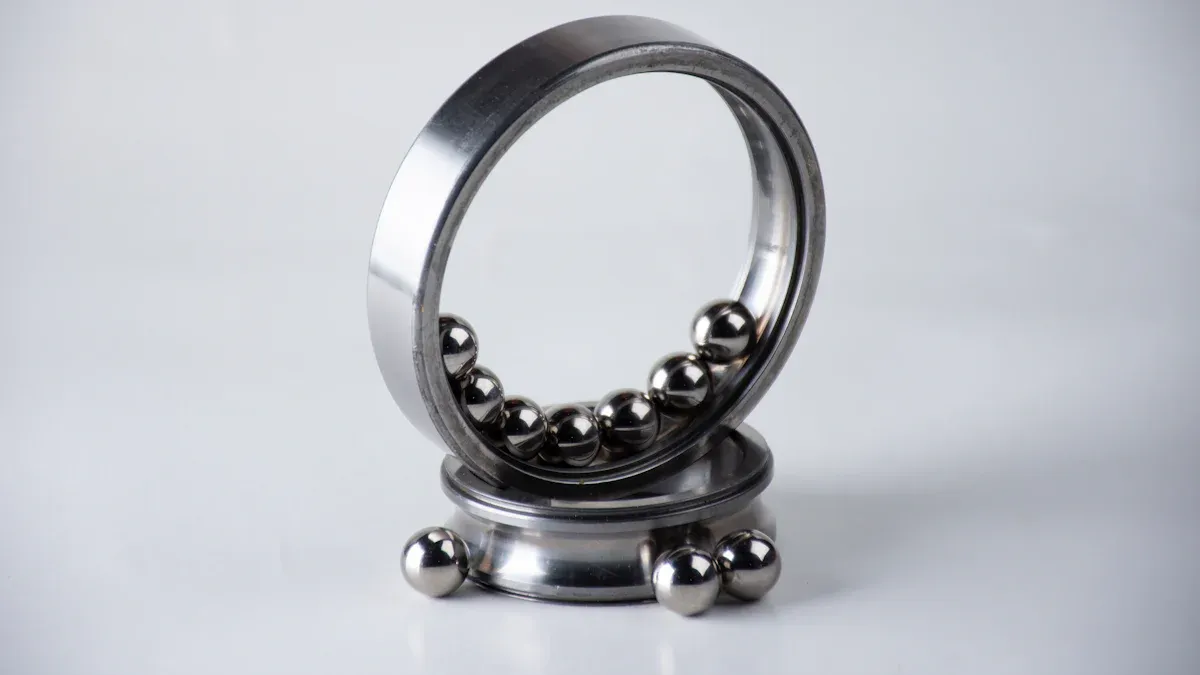










A ball bearing is a rolling-element bearing. It uses small balls to keep moving parts apart. Ball bearings are found in many machines. They help things move smoothly. Their main jobs are to carry loads and reduce friction. They also let parts spin or move easily.
Ball bearings lower friction. This saves energy and helps machines last longer.
They help motors and wheels spin smoothly. This makes machines work better.
Many industries use them to keep equipment working well. They also help lower maintenance needs.
Ball bearings lower friction. This helps machines work well and last longer.
There are different types of ball bearings. Each type is made for a special job. Deep groove bearings are good for many uses. Thrust bearings can hold heavy things.
Picking the right size and material for bearings is very important. It helps machines work their best.
Things like washing machines and cars need ball bearings to work right.
Taking care of bearings often can stop damage. This helps machines keep working well.

A ball bearing is a simple but important part in many machines. You will find it wherever you see things that spin or move smoothly. The main parts include two rings, called races, and a set of small balls. The balls sit between the races. When you use a ball bearing, the balls roll instead of slide. This rolling action makes movement easier and smoother.
Here is a table to help you understand how the parts work together:
Component | Function | Description |
|---|---|---|
Balls | Maintain separation between races | The balls roll and keep the races apart. They help reduce friction and carry loads. |
Races | Contain the balls and transmit loads | One race stays still, and the other moves. The races guide the balls. |
Rolling motion | Reduces friction compared to sliding | Rolling creates less resistance than sliding, so things move more easily. |
You will see that bearings do three main jobs in machines:
They reduce rotational friction. This means parts can spin with less effort.
They support radial loads. These are forces that push from the side.
They support axial loads. These are forces that push along the axis or center.
Bearings help machines run better by making movement smooth and easy. You will notice that when you use a bike or a skateboard, the wheels turn freely because of bearings inside. The balls inside the bearing keep the races apart, so the parts do not rub directly against each other. This design lowers friction and helps the bearing last longer.
Manufacturers check the quality of ball bearing assemblies by looking for non-circularity. If the bearing is not perfectly round, it will not work well. Even a small mistake in shape can cause problems in how the bearing performs.
Tip: When you choose bearings for a project, always look for ones that roll smoothly and feel solid. This helps your machines last longer and work better.

Ball bearings have different types. Each type is made for a special job. Some work better for fast movement. Others are good for heavy loads or tough places.
Deep groove ball bearings are the most popular type. They work in many machines. These bearings handle both side and center forces. Their shape helps lower friction. They can spin very fast. You will see them in motors, home appliances, cars, and office machines.
Characteristic/Application | Description |
|---|---|
Versatility | Deep groove ball bearings fit many uses. They work well in factories and other places. |
Low Friction | They are built to cut down friction. This makes machines work better. |
High-Speed Capability | They are good for fast spinning parts. This keeps things running smoothly. |
Common Uses | You find them in motors, appliances, cars, and office machines. |
Note: Deep groove ball bearings are used more than any other type. Their many uses make them a top pick for lots of jobs.
Angular contact bearings have a special shape. The rings touch at an angle. This lets them hold more force along the center. If the angle gets bigger, they can hold even more force. You see these bearings in pumps and gearboxes. They work where both side and center forces happen.
Feature | Angular Contact Ball Bearings | Other Bearings |
|---|---|---|
Contact Angle | 15° to 25° | 8° (Radial Bearings) |
Load Capacity | High | Lower |
Design | One raised shoulder | Standard shoulder |
Application | High-load jobs | Regular jobs |
Angular contact bearings hold more force along the center.
Their special shape lets them carry bigger loads.
Thrust bearings help with forces that push along a shaft. You see them where parts spin and hold weight from one side. These bearings are used in cars, planes, and big machines. They help gears shift smoothly. They also help pumps and turbines work well.
Application Area | Performance Advantages |
|---|---|
Aerospace | They help planes take off and land safely. They are important for building vehicles. |
Industrial Machinery | They hold center forces and help fans and pumps spin better. |
Machine Tooling | They are needed for lathes and milling machines. They stop problems from happening. |
Power Generation | They are used in turbines and generators. They help make electricity. |
In cars, thrust bearings help gears shift and power move.
In factories, they keep machines safe and cut down on stops.
Miniature and precision bearings are tiny but very exact. You find them in small spaces where movement must be perfect. These bearings are used in medical tools, robots, and plane parts. Precision bearings are made with strict rules. They work well in machines that need high accuracy.
Type of Bearing | Tolerances | Typical Applications |
|---|---|---|
Precision Bearings | Sorted by ISO classes (P0, P6, P5, P4, P2) for how much they can be off | Used in machines that need to be very exact |
Miniature Bearings | Tolerances change for each job | Used in robots and medical tools where space is small |
Medical tools use these bearings for smooth and exact moves.
Robots and planes need them for careful control.
Polymer bearings are made from plastic, not metal. They are lighter and do not rust. These bearings do not need oil or grease. They can work in wet or chemical places. Metal bearings might rust or break there.
Property/Benefit | Polymer Ball Bearings | Metal Ball Bearings |
|---|---|---|
Self-lubrication | Yes | No |
Corrosion resistance | High | Low |
Weight | Lighter than metal | Heavier than polymer |
Vibration levels | Lower with PEEK, higher with PTFE | Higher |
Applications | Good for wet or chemical places | Used for regular jobs |
Tip: If you need a bearing for a special place, polymer bearings are a smart choice.
Bearings are in many things you use every day. They help your home work well. When you use a washing machine, bearings help the drum spin fast and quiet. Refrigerator fans and air conditioners need bearings to move cool air. You also find bearings in power tools and blenders. Computer fans use bearings to keep parts from getting too hot. Many electronics, like DVD players and game consoles, use bearings. Bearings help moving parts work without sticking.
Here are some common devices that use bearings:
Washing machines and dryers
Refrigerators and air conditioning units
Blenders and food processors
Ceiling fans and vacuum cleaners
Computer fans and gaming consoles
Electric scooters and hoverboards
Tip: If you hear odd sounds from these devices, the bearings might be worn out.
Factories and workshops need bearings to work well. Machines that cut or press heavy things use bearings. Bearings lower friction and help machines last longer. They also help save energy. New bearing designs let machines run faster and with less shaking. This means fewer stops and less fixing.
Here is how bearings help in industry:
Lower friction and wear to save energy.
Hold heavy loads and stop early breakdowns.
Cut the chance of sudden stops.
Make machines use energy better and keep oil working longer.
Let machines go fast with less shaking.
Keep dust and water out to protect parts.
Save money by needing fewer repairs.
You should be careful when you put in bearings. Use oil and clean them often to help them last. Many companies check bearings to stop problems before they start.
You count on bearings when you ride in cars or fly in planes. In cars, bearings help engines and wheels move smoothly. They lower friction and help save fuel. Bearings also keep parts from wearing out too fast. In planes, bearings must be strong and exact. Landing gear bearings hold heavy loads and strong shaking. They keep planes safe when taking off and landing.
Bearings in these jobs must:
Work well in all kinds of weather.
Handle stress and go fast many times.
Keep things safe by holding heavy loads and lowering shaking.
Help engines and moving parts work smoothly to save fuel.
One ball bearing can help make cars and planes safer and better. New bearing designs help cars and planes run quiet, safe, and smooth.
Bearings come in many sizes and shapes. Each size fits a special job. Some bearings are tiny for computer fans. Others are big for heavy machines. You can look at the main measurements in this table:
Measurement Type | Description |
|---|---|
Bore diameter (d) | Inner diameter of the bearing |
Outer diameter (D) | Total outer diameter of the bearing |
Width or height (B) | Thickness of the bearing |
Edge radius (r) | Radius at the edge of the bearing |
Common Series | 6200 and 6300 |
Size Range | 10 x 30 x 9 mm to 150 x 320 x 65 mm |
Measurement Units | Millimeters and inches |
Most bearings are round. Some have special shapes for certain machines. The right size and shape help bearings last longer and work better.
Bearings use different materials for different jobs. Here is a table to compare them:
Material | Advantages | Common Applications |
|---|---|---|
Steel | Strong, does not wear out fast, costs less | Manufacturing, electric vehicles, packaging |
Stainless Steel | Does not rust, stays strong in wet places | Medical, labs, food, wet environments |
Handles heat, resists chemicals, blocks electricity | Semiconductors, medical, clean rooms | |
Ceramic | Light, low friction, runs without oil, quiet | Motors, aerospace, racing, labs, underwater |
Stainless steel bearings do not rust. You can use them in wet or chemical places.
Ceramic bearings are quiet and stay cool. They work well at high speeds and make less noise.
Polymer bearings do not need oil or grease. They stay smooth and quiet in tough places.
Tip: Polymer bearings use special plastics. They work without extra oil. They resist rust and handle high heat.
You must pick the right bearings for your project. Here are some reasons why size, shape, and material matter:
Different jobs need different bearing sizes and shapes.
The right material helps bearings last longer and work better.
Stainless steel bearings fight rust in wet places.
Ceramic bearings lower noise and wear in fast or quiet machines.
Polymer bearings work without oil, so you save time and avoid messes.
Heavy loads, high speeds, and tough places change which bearings you need.
The shape of the housing and shaft changes how bearings fit and move.
Good choices help machines run smoothly and stop breakdowns.
Note: Picking the right bearings keeps machines safe, quiet, and strong. You also help the environment by choosing materials that last longer and need less care.
Ball bearings help you reduce friction and support loads in machines. You find five main parts in every ball bearing:
Component | Description |
|---|---|
Outer ring | Guides balls and attaches to the stationary part. |
Inner ring | Moves with the rotating part and guides ball movement. |
Balls | Carry loads and roll between the rings. |
Cage/retainer | Keeps balls spaced evenly and stops extra friction. |
Seals/Shield | Blocks dirt and keeps lubricant inside for longer life. |
You can choose from different types and materials to match your needs:
Steel bearings work well for most jobs.
Ceramic bearings run fast and quiet.
Plastic bearings stay light and resist chemicals.
Knowing these options helps you pick the best bearing for your project. Ball bearings make modern technology possible, from bikes to cars and factories. You can answer the question simply: Ball bearings are key parts that let machines move smoothly, last longer, and work better.
You use a ball bearing to help parts move smoothly. It lowers friction and supports loads. Machines last longer and work better with ball bearings inside.
You find ball bearings in bikes, cars, fans, washing machines, and computers. Many tools and toys use them. Ball bearings help anything that spins or moves.
You hear grinding or squeaking sounds. You feel rough movement or notice parts do not spin easily. You see extra heat or vibration. Replace the bearing to fix these problems.
You can clean some ball bearings with special grease or cleaner. Dry them well before reuse. If you see damage or rust, you should replace them.
Material | Best Use |
|---|---|
Steel | Everyday machines |
Stainless Steel | Wet or chemical places |
Ceramic | Fast, quiet machines |
Polymer | Light, rust-free jobs |
Tip: Choose the material that matches your project for better results.
Copyright © 2023 Shandong Yunfan Precision Bearing Co., Ltd. All Rights Reserved. Technology by leadong.com